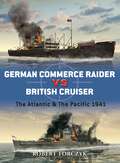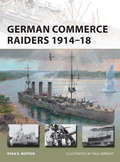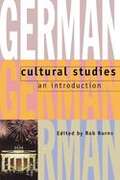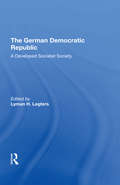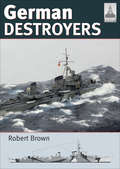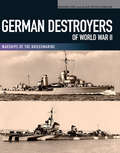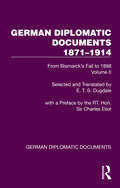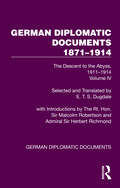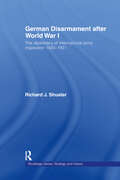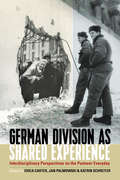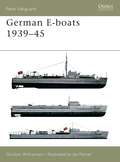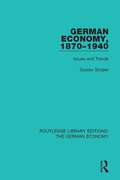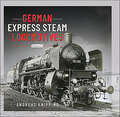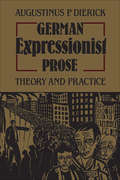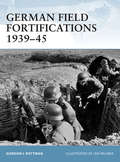- Table View
- List View
German Commerce Raider vs British Cruiser
by Robert Forczyk Ian PalmerDuring World War II, the Kriegsmarine armed a number of merchant vessels with concealed guns and torpedo tubes for surprise attacks against Allied shipping. To counter this deadly threat, the Royal Navy employed cruisers and their intelligence-gathering apparatus to find and destroy the disguised German commerce raiders. This Duel title covers the deadly game of cat and mouse, fought by these surface vessels during World War II.
German Commerce Raiders 1914-18
by Paul Wright Ryan NoppenThis is the story of Germany's commerce raiders of World War I, the surface ships that were supposed to starve the British Isles of the vast cargoes of vital resources being shipped from the furthest reaches of the Empire. To that end pre-war German naval strategists allocated a number of cruisers and armed, fast ocean liners, as well as a complex and globe-spanning supply network to support them - known as the Etappe network. This book, drawing on technical illustrations and the author's exhaustive research, explains the often overlooked role that the commerce raiders played in World War I. Whilst exploring the design and development of the ships, it also describes their operational history, how they tied up a disproportionate amount of the British fleet on lengthy pursuits, and how certain raiders such as the SMS Emden were able to wreak havoc across the oceans.
German Cultural Studies: An Introduction
by Rob BurnsMajor changes have been taking place in the context of German Studies in both secondary and higher education, with the focus shifting to a broader range of cultural forms. Based on the view that cultures are the products of class, place, gender, and race,German Cultural Studiestakes account of these changes and adopts an interdisciplinary approach in its wide-ranging study of German culture and society since 1871. Emphasizing recent and contemporary developments, the book features chronological sections on Imperial Germany, the Weimar Republic, the Third Reich, the German Democratic Republic, and the Federal Republic. The contributors chart the growth of modernization and the culture industry in Germany, and examine the extent to which culture in any given period functions as an instrument of ideological manipulation or critical enlightenment. Throughout, the emphasis is on the interactions of culture, society and ideology, and the role of culture in both public and private consciousnesses. Copiously illustrated, and with a comprehensive bibliography, the volume will be essential reading for anyone interested in modern and contemporary German society and its culture.
German Culture through Film: An Introduction to German Cinema
by Robert C. Reimer Reinhard Zachau Margit M. SinkaGerman Culture through Film: An Introduction to German Cinema is an English-language text that serves equally well in courses on modern German film, in courses on general film studies, in courses that incorporate film as a way to study culture, and as an engaging resource for scholars, students, and devotees of cinema and film history. In its second edition, German Culture through Film expands on the first edition, providing additional chapters with context for understanding the era in which the featured films were produced. Thirty-three notable German films are arranged in seven chronological chapters, spanning key moments in German film history, from the silent era to the present. Each chapter begins with an introduction that focuses on the history and culture surrounding films of the relevant period. Sections within chapters are each devoted to one particular film, providing film credits, a summary of the story, background information, an evaluation, questions and activities to encourage diverse interpretations, a list of related films, and bibliographical information on the films discussed.
German Democratic Republ/h
by Lyman H. LegtersThe shifting patterns of relationships in Central and Eastern Europe require that students of international relations be well versed in the attitudes and internal structures of the nations involved. Until now, material in English on the German Democratic Republic has consisted primarily of journalistic reminiscences or narrow scholarly treatments. Recognizing the need and responding to it, the authors of this book—leaders in the study of the GDR—present an up-to-date and comprehensive look at the country, focusing on domestic political and social change. The authors are agreed that the GDR is not only here to stay, but is also a rather stable society that can withstand moderate, well-regulated processes of change. They address education, intellectual life, the military, foreign relations, and the economy, as well as the customary subjects of politics and governmental direction.
German Destroyers (Shipcraft Ser. #25)
by Robert BrownThis fully illustrated guide to building model ships covers a variety of WWII era German destroyers with info on accessories and kits of various scales. The &‘ShipCraft&’ series provides in-depth information about building and modifying model kits of famous warship types. Lavishly illustrated, each book takes the modeler through a brief history of the subject class, highlighting differences between sister-ships and changes in their appearance over their careers. Paint and camouflage details are shown with color profiles, line drawings, and scale plans. The modeling section reviews the strengths and weaknesses of available kits, lists commercial accessory sets, and provides hints on modifying and improving the basic kit. This is followed by an extensive photographic gallery of high-quality models in a variety of scales. Each volume concludes with a section on research references, including books, monographs, large-scale plans and websites. This volume covers the large and powerful German destroyers of the Second World War era. Always popular as modelling subjects, interest in them has been further increased recently by the release of a number of very fine large-scale kitsThe &‘ShipCraft&’ series provides in-depth information about building and modifying model kits of famous warship types. Lavishly illustrated, each book takes the modeler through a brief history of the subject class, highlighting differences between sister-ships and changes in their appearance over their careers. This includes paint schemes and camouflage, featuring color profiles and highly detailed line drawings and scale plans. The modeling section reviews the strengths and weaknesses of available kits, lists commercial accessory sets for super-detailing of the ships, and provides hints on modifying and improving the basic kit. This is followed by an extensive photographic gallery of selected high-quality models in a variety of scales, and the book concludes with a section on research references – books, monographs, large-scale plans and relevant web sites. This volume covers the large and powerful German destroyers of the Second World War era. Always popular as modeling subjects, interest in them has been further increased recently by the release of a number of very fine large scale kits. With its unparalleled level of visual information – paint schemes, models, line drawings and photographs – this book is simply the best reference for any model maker setting out to build one of these unusual ships.
German Destroyers 1939#45
by Ian Palmer Gordon WilliamsonThe German destroyer fleet of World War II consisted of nine classes: the Diether Von Roeder Class, the Leberecht Maas Class and the wartime classes Z23, Z35, Z37, Z40, Z43, Z46 and Z52. These vessels, though fewer in number than the British destroyer fleet, tended to be much bigger and more powerful than their allied counterparts. They served their country well in operations in the Channel, North Sea, the Far North and in the rescue of civilians from East Prussia during the final days of the war. This title describes their design, development and operational use from the fjords of Narvik to the final days of the war.
German Destroyers of World War II: Warships of the Kriegsmarine (Warships Of The Kriegsmarine Ser.)
by Gerhard Koop Klaus-Peter SchmolkeA detailed, illustrated history of the torpedo boat destroyers of the Nazi German Navy. The warships of the World War II German Navy are among the most popular subjects in naval history, and one of the best collections is the concise but authoritative six volume series written by Gerhard Koop and illustrated by Klaus-Peter Schmolke. Each book contains an account of the development of a particular class, a detailed description of the ships, with full technical details, and an outline of their service, and are heavily illustrated with plans, battle maps and a substantial collection of photographs. This volume in the series details the more than 40 German destroyers, including captured ships that saw service during World War II. Chapters range from their design and development, armament and machinery, to the differences in appearance, camouflage schemes, and modifications. This book also covers the destroyers&’ careers and the many actions they fought, complemented by illustrated plans, technical drawings, maps, and a comprehensive gallery of photographs.
German Diplomatic Documents 1871–1914 Volume 1: Bismarck’s Relations with England 1871–1890 (German Diplomatic Documents 1871–1914)
by Dugdale, E. T. S. Rennell Rodd Headlam-Morley, J. W.Originally published in English in 1928, this volume deals mainly with Anglo-German relations at the end of the 19th Century. Chancellor Otto von Bismarck’s voice can be heard clearly in the documents which give an extensive picture of the alternating phases of relations between Great Britain and Germany, as influenced by their respective obligations and interests in the international issues which united or divided the Powers over a period of twenty years. The strongest impression which these documents leave is the revelation of how greatly the mentality of the western world changed since they were drafted, and especially during the decade which came after World War I. The shaping of policy, as exhibited in these despatches and memoranda, is governed almost exclusively by the ultimate idea of war as the deciding factor. The menace of war and the prospects of success or failure in aggression or defence appear to be the essential motives of policy.
German Diplomatic Documents 1871–1914 Volume 2: From Bismarck's Fall to 1898 (German Diplomatic Documents 1871–1914)
by Charles Eliot Dugdale, E. T. S.Originally published in English in 1929, this second volume of the German Diplomatic Documents covers a much shorter period: 1890–1898. During this period there was no war or revolution in Europe, but the sphere of German and indeed European politics became enlarged. The documents in this volume deal with questions raised by diverse regions such as Armenia, Morocco, Tunisia, Tripoli, South Africa, Crete and Cuba. The papers here reissued show that colonial expansion is a recognised part of the official German programme. As with the first volume, the policy exhibited in the despatches of this volume are governed almost exclusively by the ultimate idea of war.
German Diplomatic Documents 1871–1914 Volume 3: The Growing Antagonism 1898–1910 (German Diplomatic Documents 1871–1914)
by Dugdale, E. T. S. Maurice De BunsenOriginally published in 1930, this volume opens with some selections dealing with the situation created by the victory of Japan over China in 1904 which opened a new epoch in the history of the Far East. It includes two momentous conflicts profoundly affecting international relations – the Boer War and the Russo-Japanese War. It also touches at many points on the long discussions aiming at a naval agreement, with or without some form of general understanding, between England and Germany. Through the Alliance with Japan and the Entente with France it leads up to the separation of Europe into two rival camps, in the course of an evolution in which crisis followed crisis with increasing and often alarming intensity.
German Diplomatic Documents 1871–1914 Volume 4: The Descent to the Abyss, 1911–1914 (German Diplomatic Documents 1871–1914)
by Dugdale, E. T. S. Malcolm Robertson Herbert RichmondOriginally published in English in 1931, this fourth and final volume of documents brings the reader to the brink of World War I. The despatches beg the question of whether war was inevitable and if so, could it have been postponed? The question of whether the British Empire needed to have taken part in it, and how far its action or inaction was responsible for the outbreak is also discussed.
German Disarmament After World War I: The Diplomacy of International Arms Inspection 1920-1931 (Strategy and History)
by Richard J. ShusterGerman Disarmament After World War I examines the Allied disarmament of Germany and the challenges that such an enormous task presented to international efforts in enforcing the Treaty of Versailles. In the twenty-first century, disarmament remains a critical issue for the International community. This new book focuses on three key areas and lessons of Allied disarmament operations from 1920-31: the role and experience of international arms inspectors working amidst an embittered German populace the ramifications of the divergent disarmament priorities of the leaders of the disarmament coalition the effectiveness of united Allied policies backed by sanctions. These major issues are examined within the overall context of the assessment of Allied disarmament operations in Germany. While some historians perceive German disarmament as a failure, this book argues that arms inspectors successfully destroyed Germany’s ability to pose a military threat to European security. This new study shows how the destructive legacy of war convinced the victorious nations, especially Britain and France, of the importance in minimizing German military strength. French post-war security concerns, however, were often faced with the unwillingness of Britain to enforce the totality of the military articles of the treaty. German obstruction also influenced Allied disarmament policies. German Disarmament After World War I examines the initial effectiveness of Allied disarmament efforts in Germany and explains how they ultimately disappeared through diverging conceptions of a post-war world. This book will be of great interest to all students of disarmament, the interwar period and of military history, modern European history and security studies.
German Division as Shared Experience: Interdisciplinary Perspectives on the Postwar Everyday
by Jan Palmowski Erica Carter Katrin SchreiterDespite the nearly three decades since German reunification, there remains little understanding of the ways in which experiences overlapped across East-West divides. German Division as Shared Experience considers everyday life across the two Germanies, using perspectives from history, literary and cultural studies, anthropology and art history to explore how interconnections as well as fractures between East and West Germany after 1945 were experienced, lived and felt. Through its novel approach to historical method, the volume points to new understandings of the place of narrative, form and lived sensibility in shaping Germans’ simultaneously shared and separate experiences of belonging during forty years of division from 1945 to 1990.
German Division as Shared Experience: Interdisciplinary Perspectives on the Postwar Everyday
by Katrin Schreiter Erica Carter, Jan PalmowskiDespite the nearly three decades since German reunification, there remains little understanding of the ways in which experiences overlapped across East-West divides. German Division as Shared Experience considers everyday life across the two Germanies, using perspectives from history, literary and cultural studies, anthropology and art history to explore how interconnections as well as fractures between East and West Germany after 1945 were experienced, lived and felt. Through its novel approach to historical method, the volume points to new understandings of the place of narrative, form and lived sensibility in shaping Germans’ simultaneously shared and separate experiences of belonging during forty years of division from 1945 to 1990.
German E-boats 1939-45
by Ian Palmer Gordon WilliamsonBy the outbreak of World War II, Germany had done much to replace the Kaiser's High Seas Fleet, which was scuttled following their surrender at the end of World War I. Forced to build anew, the Kriegsmarine possessed some of the most technically advanced warships in existence. Although the heavy units of the fleet were too small in number to pose much of a threat, Germany was particularly well served by her Navy's smaller vessels, in particular the U-Boats and the S-Boats. Known to the allies as the E-Boats ('Enemy'), they performed sterling duties in the Black Sea and English Channel, where they became a particular scourge.
German Economy, 1870-1940: Issues and Trends (Routledge Library Editions: The German Economy #12)
by Gustav StolperOriginally published in 1940, this book remains an illuminating and forceful survey of the economic development of modern Germany. It reveals for the first time the basic trends of German business enterprise towards central control. This survey makes three important factors clear. Firstly, the continuity in the underlying trends of German history; secondly the characteristic prevalence of 'statism' in German history; thirdly, Nazism cannot be explained on purely economic grounds: no other county showed such a striking sequel of ups and downs as that which this book illustrates in the economic history of the late 19th and early 20th centuries.
German Exile Politics: The Social Democratic Executive Committee in the Nazi Era
by Lewis J. EdingerThis title is part of UC Press's Voices Revived program, which commemorates University of California Press’s mission to seek out and cultivate the brightest minds and give them voice, reach, and impact. Drawing on a backlist dating to 1893, Voices Revived makes high-quality, peer-reviewed scholarship accessible once again using print-on-demand technology. This title was originally published in 1956.
German Existentialism
by Martin Heidegger“On the day of German Labor, on the day of the Community of the People, the Rector of Freiburg University, Dr. Marin Heidegger, made his official entry into the National Socialist Party.” And so begins one of the most controversial philosophical texts available today. Heidegger, a German Nationalist and proud Nazi, thoroughly examines the history, the philosophy, and the rise to power of the Nazi movement in Germany. Martin Heidegger’s distinguished Italian colleague, Professor Benedetto Croce, said of his German contemporary, “This man dishonors philosophy and that is an evil for politics too.” Croce’s severe rebuke was not singular at the time when Hitlerism was rampant over Europe. It is true that among the almost one thousand professional philosophers of Germany and Austria only very few actively opposed National Socialism. On the other hand, no one degraded his historic profession in the manner Heidegger did, by becoming a spokesman for National Socialism and attempting to mold his theories into one pattern with Hitlerism. Heidegger’s contribution to the growth and development of National Socialism was immense. In this small anthology Dr. Runes endeavors to point to the utter confusion Heidegger created by drawing, for political and social application of his own existentialism metaphysics, upon the decadent and repulsive brutalization of Hitlerism. Martin Heidegger was a philosopher most known for his contributions to German phenomenological and existential thought. Heidegger was born in rural Messkirch in 1889 to Catholic parents. While studying philosophy and mathematics at Albert-Ludwig University in Freiburg, Heidegger became the assistant for philosopher Edmund Husserl. Influenced by Husserl, Kierkegaard, and Nietzsche, Heidegger wrote extensively on the quality of Being, including his opus Being and Time. He served as professor of philosophy at Albert-Ludwig University and taught there during the war. In 1933, Heidegger joined the National Socialist German Worker’s (or Nazi) Party and expressed his support for Hitler in several articles and speeches. After the war, his support for the Nazi party came under attack, and he was tried as a sympathizer. He was able to return to Albert-Ludwig University, however, and taught there until he retired. Heidegger continued to lecture and write until his death 1973.
German Express Steam Locomotives
by Andreas KnippingIn this book, the author defines the express stem locomotive on the basis of the mandatory criterion of large drive wheels, and studies its evolution from around 1850 to the last refinements made around 1960, with many wrong turns and great successes along the way. This highly illustrated work features over 6,000 German express steam locomotives, including the oldest, the 1A1 and the Crampton; the largest, the Prussian S3; the fastest, the Reichsbahn-05; arguably the most successful, the Bavarian S3/6; and the most powerful, the Bundesbahn's oil-fired three-cylinder 01.
German Expressionist Prose: Theory and Practice
by Augustinus DierickAn extreme sensitivity to gathering social crisis, an accompanying angry enthusiasm for artistic experimentation and renewal – this compelling mix in German art, poetry, and drama of the period 1910 to 1925 continues to draw both scholarly attention and intense popular interest. In this book Augustinus Dierick focuses on another significant but hitherto neglected medium of German Expressionist thought – short narrative prose – in order to illuminate and evaluate the contribution of that genre to one of the twentieth century's most powerful artistic movements. Dierick's study includes a thorough analysis of the works of a broad range of Expressionist prose writers, from those of such specialists in the genre as Edschmid, Heym, Benn, Loerke, Frank, Sternheim, Ehrenstein, and 'Mynona' to the shorter prose works of such major figures as Alfred Döblin, Heinrich Mann, Max Brod, and Franz Werfel. Dierick isolates the thematic obsessions common among Expressionist writers: the pathos of the self in confrontation with nature and with God, the tension between self and the institutions of bourgeois society, and the attractions and dangers of eroticism. Throughout Dierick stresses the interrelationship between themes and their formal expression. He examines many apparent excesses in style and tone, many aberrations in structure and generic characteristics, and identifies them not as needless experimentation but as a necessary result of the attempt to find appropriate forms for extreme situations and complex ideas. Dierick's analysis makes clear that Expressionist prose has an intrinsic artistic value and, because of certain nuances and different accents, must be included in any estimation of the nature and importance of Expressionism as a whole.
German Fantasia
by Philippe ClaudelA deserting soldier treks through the torn-up countryside and abandoned villages, trying to distance himself from the atrocities of war.An elderly man sits beneath lime trees, remembering his first sexual encounter one summer night with a female stranger who whispered another man's name.A young woman takes up a job in a care home, spending monotonous days scrubbing floors and yearning to dance at the local nightclub.The artist Franz Marc lives on in an imagined life as a patient at an asylum, before falling victim to Hitler's policy of Gnadentod.Finally, a young Jewish girl, the life she once knew destroyed, holds her memories close as she finds refuge in wreckage of her homeland.And throughout there is the shadowy presence of Viktor - one man or many? A looming figure in Germany's own reckoning with its past.Through these five interconnected stories, Philippe Claudel reflects on Germany's complex history and the experiences of its people, dismantling the idea of "a nation" or "a people" and exploring the malleability of memory.
German Façade Design: Traditions of Screening from 1500 to Modernism
by Randall OttGerman architecture prior to the modern period has received less systemic, analytical study than that of Italy, France, and Britain. Scholarly discussion of broad traditions or continuities within Germanic or Central European façade design is even sparser. Baroque era studies of the region mostly devote themselves to isolated architects, monuments, or movements. Modernism's advent decisively changed this: Germanic architecture enjoyed sudden ascendancy. Yet, even so, study specifically of that region's façades still lagged – nothing compares to the dozens of treatments of Le Corbusier's façade systems, for example, and how these juxtapose with French neoclassical or Italian Renaissance methods. Given the paucity of multi-period studies, one can be forgiven for believing Germany's effervescence of radical, modern works seems unprecedented. This book takes up these multiple quandaries. It identifies and documents a previously unrecognized compositional tradition - characterized here as the 'screen façade' – and posits it as a counter-narrative critiquing the essentialist, 'authentic' canon currently dominant in Western architectural history. By crossing evenly over the dividing line between the historical and modern periods, it offers valuable insights on indigenous roots underlying some aspects of Germany's invigorating early twentieth-century architectural developments. The book chronologically examines 400 years of closely related facades, concentrated in Germany but also found in Austria, the Czech Republic, German-speaking Switzerland, and nearby areas of Central Europe. While nearly 75 buildings are mentioned and illustrated, a dozen are given extensive analysis and the book focuses on the works of three architects – Schinkel, Behrens and Mies. Relationships between examples of these three architects' façades far transcend mere homage amongst masters. Glimmers of the system they eventually codify are apparent as early as at Heidelberg Castle in 1559 and Nürnberg's Rathaus in 1622. The book argues that in Germany, northern Gothic affinities for bisection, intense repetition and rote aggregation intersected with southern Classical affinities for symmetry, hierarchy and centrality, thereby spawning a unique hybrid product – the screen. Instead of graphic formality, this study is guided by on-site perceptions, propositional contrasts, means of approach, interpretive conflicts and emotion and it relates the design of these façades to concepts proposed by contemporary philosophers including Novalis, Hegel, Nietzsche, Freud, Adorno, and, most importantly, Gadamer on hermeneutics.
German Façade Design: Traditions of Screening from 1500 to Modernism
by Randall OttGerman architecture prior to the modern period has received less systemic, analytical study than that of Italy, France, and Britain. Scholarly discussion of broad traditions or continuities within Germanic or Central European façade design is even sparser. Baroque era studies of the region mostly devote themselves to isolated architects, monuments, or movements. Modernism's advent decisively changed this: Germanic architecture enjoyed sudden ascendancy. Yet, even so, study specifically of that region's façades still lagged – nothing compares to the dozens of treatments of Le Corbusier's façade systems, for example, and how these juxtapose with French neoclassical or Italian Renaissance methods. Given the paucity of multi-period studies, one can be forgiven for believing Germany's effervescence of radical, modern works seems unprecedented. This book takes up these multiple quandaries. It identifies and documents a previously unrecognized compositional tradition - characterized here as the 'screen façade' – and posits it as a counter-narrative critiquing the essentialist, 'authentic' canon currently dominant in Western architectural history. By crossing evenly over the dividing line between the historical and modern periods, it offers valuable insights on indigenous roots underlying some aspects of Germany's invigorating early twentieth-century architectural developments. The book chronologically examines 400 years of closely related facades, concentrated in Germany but also found in Austria, the Czech Republic, German-speaking Switzerland, and nearby areas of Central Europe. While nearly 75 buildings are mentioned and illustrated, a dozen are given extensive analysis and the book focuses on the works of three architects – Schinkel, Behrens and Mies. Relationships between examples of these three architects' façades far transcend mere homage amongst masters. Glimmers of the system they eventually codify are apparent as early as at Heidelberg Castle in 1559 and Nürnberg's Rathaus in 1622. The book argues that in Germany, northern Gothic affinities for bisection, intense repetition and rote aggregation intersected with southern Classical affinities for symmetry, hierarchy and centrality, thereby spawning a unique hybrid product – the screen. Instead of graphic formality, this study is guided by on-site perceptions, propositional contrasts, means of approach, interpretive conflicts and emotion and it relates the design of these façades to concepts proposed by contemporary philosophers including Novalis, Hegel, Nietzsche, Freud, Adorno, and, most importantly, Gadamer on hermeneutics.
German Field Fortifications 1939-45
by Gordon Rottman Ian PalmerThe German Army of World War II considered itself an offensive, mobile force. The experiences in the trenches in World War I had done much to shape its concept of field fortification, and its mobile warfare ethos was intended to prevent the previous war's stalemate. This book addresses frontline defensive field fortifications, built by infantrymen using local materials, and includes rifle platoon positions, trenches, crew-served weapon positions, bunkers, dugouts, shelters and more. It also covers anti-tank and anti-personnel obstacles, as well as field camouflage methods and construction methods. The integration of these positions into permanent systems and theatre-specific defences are also discussed.
